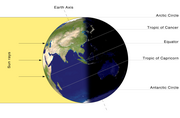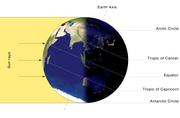Seasons
Seasons are divisions of a year with four distinct seasons: spring, summer, autumn and winter, per year. On the surface of the Earth at mid to high latitudes, seasons are generally associated with changes in weather and climate. In terms of astronomy, different constellations are visible in different seasons due to the orbit of the Earth around the Sun.
Contents |
Cause of Seasons
Seasons are caused by a combination of the Earth's orbit around the Sun and the tilt of the Earth's axis with respect to the Earth's orbit. Since the North and South poles of the Earth point to the same point in the sky regardless of where in the orbit the Earth is, there are times when a pole is pointed towards or away from the Sun. For purposes of this article, we will look at the North pole and seasons in the northern hemisphere. The seasons are reversed in the southern hemisphere.
Summer
During the summer season, the Earth's North pole is pointed towards the Sun. This causes the Sun's rays to hit the Earth's surface close to vertical. This concentrates the Sun's energy over a small area, causing more heating. This gives warmer days during the summertime.
Astronomically speaking, summer begins on the summer solstice, the point in the Earth's orbit when the North pole is pointed towards the Sun. This occurs around the 21st of June each year. Since the pole is pointed towards the Sun, this is also the day of the year with the greatest number of hours of daylight and the shortest night.
The following constellations are considered summer constellations as they tend to be near the meridian during the summer months:
- Apus
- Aquila
- Ara
- Corona Australis
- Corona Borealis
- Cygnus
- Delphinus
- Draco
- Hercules
- Libra
- Lupus
- Lyra
- Norma
- Ophiuchus
- Pavo
- Sagitta
- Sagittarius
- Scorpius
- Scutum
- Serpens
- Telescopium
- Triangulum Australe
- Ursa Minor
- Vulpecula
Autumn
Autumn, sometimes called fall, is a season that occurs when the Earth's pole is half way between summer and winter solstices. With the pole starting to point away from the Sun, the Sun's rays are at a greater angle from the vertical and start to spread the Sun's energy over a greater area, causing less solar heating on the ground. This causes Autumn to be cooler than the summertime.
Astronomically, Autumn begins with the autumnal equinox which occurs around the 22nd of September. On this date, day and night are roughly of equal length.
The following constellations are considered autumn constellations as they tend to be near the meridian during the autumn months:
- Andromeda
- Aquarius
- Aries
- Capricornus
- Cassiopeia
- Cepheus
- Cetus
- Equuleus
- Fornax
- Grus
- Hydrus
- Indus
- Lacerta
- Microscopium
- Octans
- Pegasus
- Phoenix
- Pisces
- Piscis Austrinus
- Sculptor
- Triangulum
- Tucana
Winter
During the winter season, the Earth's North pole is pointed away from the Sun. This causes the Sun's rays to hit the Earth's surface at a large angle from the vertical. This spreads the Sun's energy over a large area, causing less heating. This gives colder days during the wintertime.
Astronomically speaking, winter begins on the winter solstice, the point in the Earth's orbit when the North pole is pointed away from the Sun. This occurs around the 21st of December each year. Since the pole is pointed away from the Sun, this is also the day of the year with the least number of hours of daylight and the longest night.
The following constellations are considered winter constellations as they tend to be near the meridian during the winter months:
- Auriga
- Caelum
- Camelopardalis
- Cancer
- Canis Major
- Canis Minor
- Columba
- Dorado
- Eridanus
- Gemini
- Horologium
- Lepus
- Lynx
- Mensa
- Monoceros
- Orion
- Perseus
- Pictor
- Puppis
- Reticulum
- Taurus
- Volans
Spring
Spring, is a season that occurs when the Earth's pole is half way between winter and summer solstices. With the pole starting to point towards the Sun, the Sun's rays are at a smaller angle from the vertical and start to spread the Sun's energy over a smaller area, causing more solar heating on the ground. This causes spring to be warmer than the wintertime.
Astronomically, spring begins with the vernal equinox which occurs around the 22nd of March. On this date, day and night are roughly of equal length.
The following constellations are considered spring constellations as they tend to be near the meridian during the spring months:






